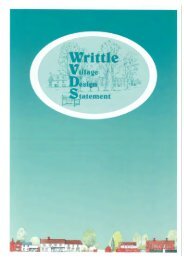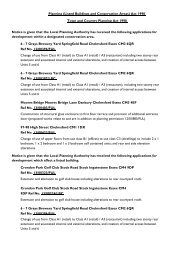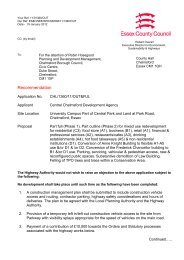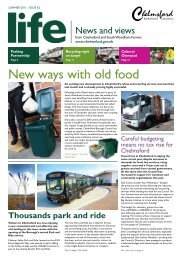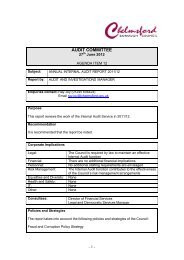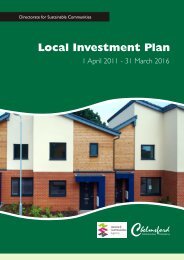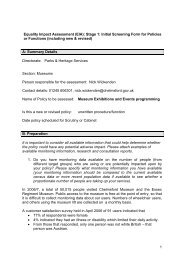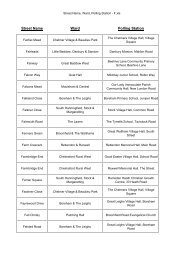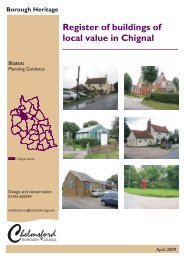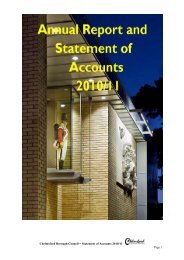20Historic Environment Designations2.3.26 A variety of historic environment sites and features within the Study Area are protected inrecognition of their historical, archaeological and/or architectural value. These are describedbelow:Scheduled Monuments2.3.27 There are 145 nationally important archaeological sites within Study Area (compared to 297in Essex as a whole), which are protected under the Ancient Monuments and ArchaeologicalAreas Act (1979). These include: Braintree - 36 Scheduled Monuments Brentwood - 12 Scheduled Monuments <strong>Chelmsford</strong> - 13 Scheduled Monuments Maldon - 15 Scheduled Monuments Uttlesford - 72 Scheduled MonumentsConservation Areas2.3.28 There are 122 Conservation Areas of special architectural or historical interest within theStudy Area (compared to 209 in Essex as a whole) protected under the Listed Building andConservation Areas Act 1990. These include: Braintree - 39 Conservation Areas Brentwood - 13 Conservation Areas <strong>Chelmsford</strong>: 24 Conservation Areas Maldon - 11 Conservation Areas Uttlesford - 35 Conservation AreasRegistered Historic Parks and Gardens2.3.29 There are 27 designed landscapes with the Study Area (compared to 37 in Essex as a whole),which are included on the English Heritage non-statutory national Register of Parks andGardens of Special Historic Interest. These include: Braintree - 9 Registered Historic Parks and Gardens (Belchamp Hall, Faulkbourne Hall,Glazenwood, Gosfield Hall, Hatfield Priory, Saling Grove, Saling Hall, Spains Hall andTerling Place). Brentwood - 3 Registered Historic Parks and Gardens (Thorndon Park, Warley Place andWeald Park). <strong>Chelmsford</strong> - 6 Registered Historic Parks and Gardens (Boreham House, Danbury Park,Hylands Park, Langleys, New Hall, Boreham and Riffhams). Maldon - 1 Registered Historic Parks and Garden (Braxted Park). Uttlesford - 7 Registered Historic Parks and Gardens (Audley End, Bridge End Gardens,Down Hall, Easton Lodge, Quendon Park, Shortgrove Park and The Maze, SaffronWalden).2.4 Key Forces for Change in the <strong>Landscape</strong>2.4.1 Use of land for housing, minerals, recreation, energy generation and other activities haveresulted in some places in a general erosion of the character, quality and diversity of thelandscapes within the Study Area since the mid-twentieth century. The cumulative effects ofSection 2.0 – Overview of the Study Area11100101R Final LCAs_09-06
21small-scale and incremental changes have had a particularly marked effect on the character ofthe landscape.2.4.2 The pace, mixture, and scale of landscape will continue to change in the future, which mayimpact, positively or negatively, upon those qualities that make the landscape special. A keychallenge is to understand, manage and direct future positive change in the landscape in waysthat conserve and enhance its essential characteristics and valued attributes, whilst enablingsensitively designed development to be accommodated to meet social and economic needs.2.4.3 The key global, national and local forces for change that affect the character of the StudyArea’s landscapes are considered under the following main headings: Agriculture, Land Management and Diversification Socio-Economic <strong>Character</strong>istics Infrastructure, Transport and Traffic Built Development Recreation and Tourism Mineral Extraction and Waste Climate ChangeAgriculture, Land Management and Diversification2.4.4 Agricultural activity is a vital aspect of the rural environment within the Study Area and is aprimary factor in shaping the character of the landscape. Braintree, Brentwood, <strong>Chelmsford</strong>,Maldon and Uttlesford Districts form a highly productive arable farming area. Pasture is notextensive, except in the river valleys where drainage is a constraint on cultivation.2.4.5 Agriculture has the ability to substantially enhance and detract from the character of thelandscape in a relatively short period of time, primarily due to an increase in mechanisationand intensive practices. These have, over the last fifty years, contributed to the changes inthe rural environment through intensive cropping, loss of field boundaries, introduction of alarger-scale field pattern, drainage of marshes/wetlands, and the introduction of new farmbuildings. Pastures and coastal grazing marshes are dependent on appropriate livestockgrazing practices. On some coastal grazing marshes scrub encroachment is becoming aproblem due to lack of grazing/management.2.4.6 Changes in farming practice and fluctuations in the agricultural economy have an importantimpact and these changes will only increase, as global markets become a major influencingfactor. Whilst the effects of post-1945 agricultural change on landscape character are wellunderstood, future changes may result from increasing competition in a global market place,ongoing from the reform of the Common Agricultural Policy and the proposals of theGovernment Strategy for Sustainable Farming and Food, including proposed Entry-LevelAgri-Environment Scheme (ELS) and Higher Tier Scheme, are yet to become clear. Theremay be ongoing adverse effect on character, as well as important opportunities to enhanceand restore character as a result of changes in policy.2.4.7 The area was affected by Dutch Elm disease and there has been a gradual decline intraditional hedge-laying and coppicing creating more fragmented and gappy hedgerows.2.4.8 Historically the marshes on the coastal fringe of Maldon District (aligning the BlackwaterEstuary) were utilised for purposes other than agriculture. The diverse saltmarshes provideda rich food resource (oysters) and were also utilised in early industrial activity (salt-making).With gradual agricultural and industrial change, there was pressure for more pasture andagricultural land within the coastal margins. This led to the enclosure of areas of saltmarsh11100101R Final LCAs_09-06Section 2.0 – Overview of the Study Area
- Page 1: BRAINTREE, BRENTWOOD, CHELMSFORD,MA
- Page 6 and 7: 8.0 RECOMMENDATIONS8.1 General8.2 K
- Page 8 and 9: EXECUTIVE SUMMARYBackgroundIn Octob
- Page 10 and 11: Executive Summary iv 11100101R Fina
- Page 13 and 14: 11.0 INTRODUCTION1.1 Background and
- Page 15 and 16: 3spatial planning approach should b
- Page 17 and 18: 5Proposals Map - expresses geograph
- Page 19 and 20: 7 View types and composition Landma
- Page 21 and 22: 9 the highlighting of landscape iss
- Page 23: 2.0 OVERVIEW OF THE STUDY AREA
- Page 26 and 27: 122.2.8 On the hills above the Lond
- Page 28 and 29: 142.2.22 The Essex Estuaries cSAC i
- Page 30 and 31: 16and have been found to have been
- Page 32 and 33: 18 Medieval settlement, in the pari
- Page 36 and 37: 22and drainage of other coastal wet
- Page 38 and 39: 24character. Upgrading of the rail
- Page 40 and 41: 26alternative sources from outside
- Page 42 and 43: 282.5.7 Together with the Joint Cha
- Page 44 and 45: 302.5.13 The seventy Landscape Char
- Page 46 and 47: 32Section 2.0 - Overview of the Stu
- Page 49 and 50: 1395.0 LANDSCAPE CHARACTER OF CHELM
- Page 51 and 52: 141A6 UPPER CHELMER RIVER VALLEY (s
- Page 53 and 54: 143 Fourteen CWSs with unimproved g
- Page 55 and 56: 145A7 LOWER CHELMER RIVER VALLEY (s
- Page 57 and 58: 147Suggested Landscape Planning Gui
- Page 59 and 60: 149to designed character and sense
- Page 61 and 62: 1515.3 Farmland Plateau Landscapes5
- Page 63 and 64: 153and Good Easter in the lower lyi
- Page 65 and 66: 155B16 FELSTED FARMLAND PLATEAU (sh
- Page 67 and 68: 157B17 TERLING FARMLAND PLATEAU (sh
- Page 69 and 70: 159B20 WRITTLE FARMLAND PLATEAUKey
- Page 71 and 72: 161Proposed Landscape Strategy Obje
- Page 73 and 74: 163Visual Characteristics. The A12
- Page 75 and 76: 1655.4 Drained Estuarine Marsh Land
- Page 77 and 78: 167well screened in the landscape.
- Page 79 and 80: 1695.5 Wooded Farmland Landscapes5.
- Page 81 and 82: 171enclosure and tranquillity and a
- Page 83 and 84: 173F6 WOODHAM WOODED FARMLAND (shar
- Page 85 and 86:
175enclosed meadows within river va
- Page 87 and 88:
177north, south and east. Therefore
- Page 89 and 90:
179F10 HEYBRIDGE WOODED FARMLAND (s
- Page 91 and 92:
181Suggested Landscape Planning Gui
- Page 93 and 94:
183and Ramsden Heath). Church tower
- Page 95 and 96:
185F12 EAST HANNINGFIELD WOODED FAR
- Page 97 and 98:
187 Potential major road improvemen
- Page 99 and 100:
189Historic Land UseEvidence of his
- Page 101:
8.0 RECOMMENDATIONS
- Page 104 and 105:
3428.2.3 Planners, developers, arch
- Page 106 and 107:
344Drafting Core Policies and Suppo
- Page 108 and 109:
346 Make the link between planning
- Page 110 and 111:
348 change in the degree of key fac
- Page 112 and 113:
350Section 8.0 - Recommendations111
- Page 115:
APPENDIX ASTAKEHOLDER CONSULTATION
- Page 118 and 119:
with the County assessment, but sho
- Page 120 and 121:
Fit with adjacent classificationsCB
- Page 122 and 123:
Chelmsford - Key threats to valued
- Page 124 and 125:
Appendix A - Stakeholder Consultati
- Page 126 and 127:
CBA gave a brief overview of the st
- Page 128 and 129:
9. Summary and Recommendations/Appl
- Page 130 and 131:
development planning with conservat
- Page 133 and 134:
GLOSSARYCommunity StrategyAll local
- Page 135:
APPENDIX CSOURCES OF FURTHER INFORM
- Page 138 and 139:
English Heritage, 2003, Register of
- Page 141 and 142:
HISTORIC LANDSCAPE CHARACTER AREAS
- Page 143:
APPENDIX ECURRENT LOCAL PLANNING SI
- Page 146 and 147:
Appendix E - Current Local Planning
- Page 149 and 150:
APPENDIX FDRAFT CORE STRATEGY LANDS
- Page 151:
cbawww.cba.uk.netLondon OfficeSwan



